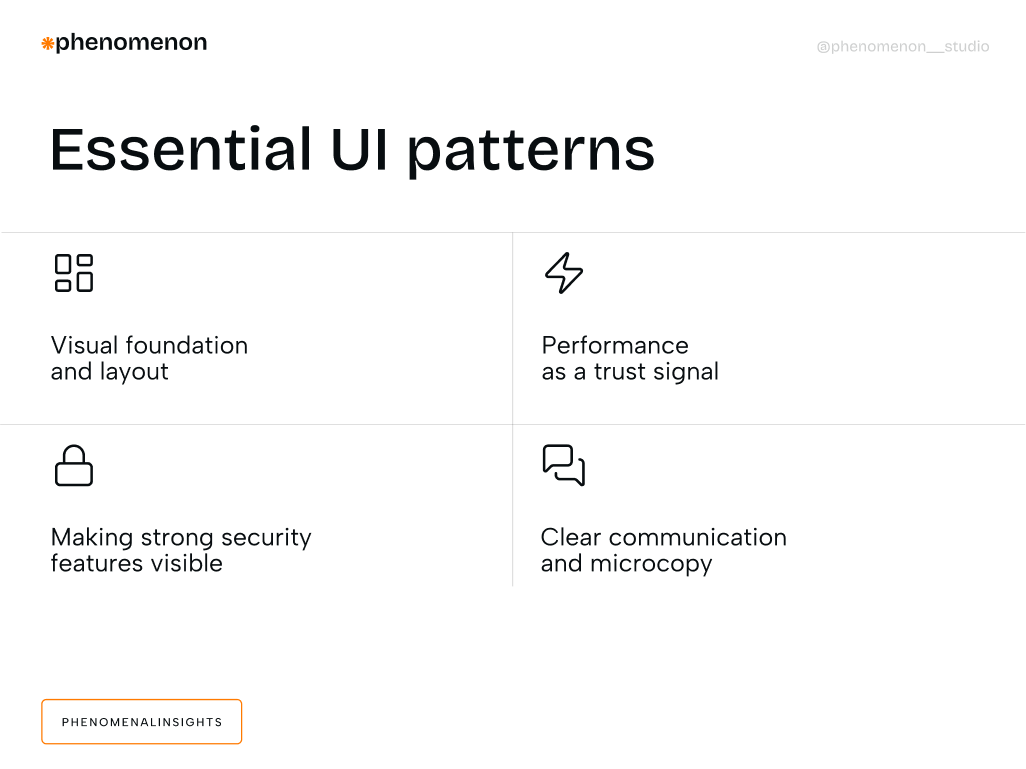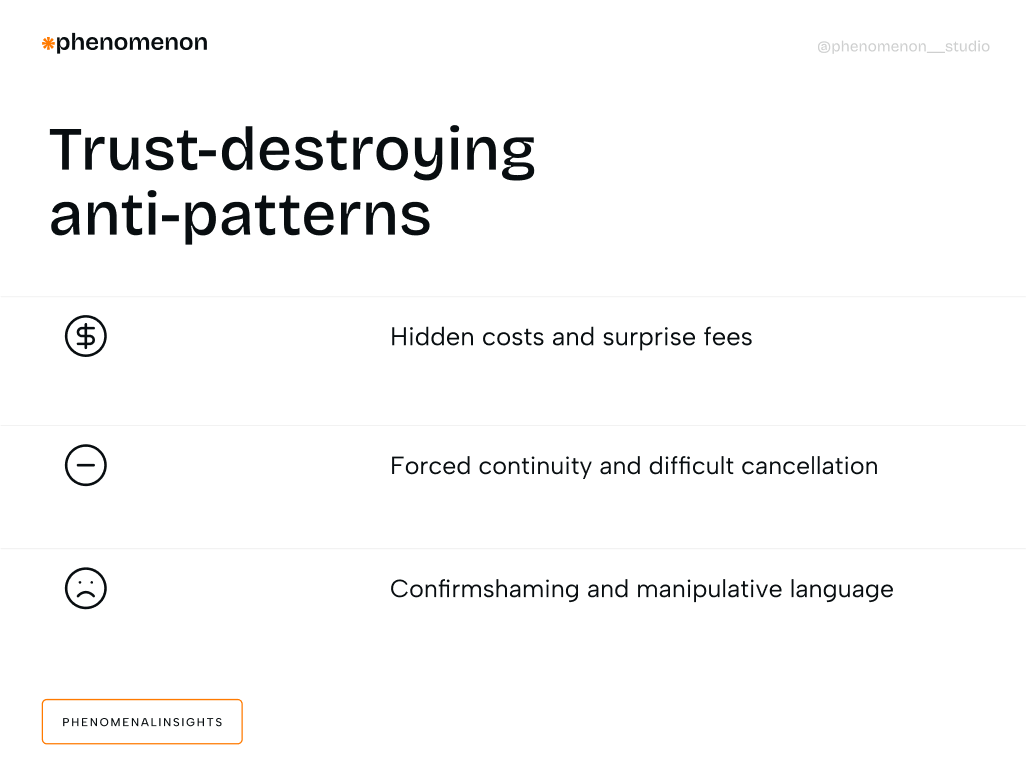Learn proven UI design patterns that build trust in FinTech apps. Discover psychology-backed strategies that turn users into loyal customers.
Building trust in financial technology isn’t just about marketing promises or security certificates. It’s about every pixel, interaction, and word users encounter when managing their money. In an industry where a single misstep can mean losing a customer forever, your interface becomes your most powerful tool for establishing credibility. Fintech UX design is a critical factor in building trust, ensuring that every aspect of the user journey feels secure and reliable.
FinTech companies face a unique challenge. Unlike traditional banks with decades of history and physical branches, digital-first platforms must earn trust entirely through their user experience and UX design. Users aren’t just downloading an app; they’re placing their financial future in the hands of a company they’ve never met. This makes interface design a critical business function, not just an aesthetic choice. The fintech industry demands tailored solutions that address its unique challenges, such as security, compliance, and rapidly evolving user expectations.
The stakes couldn’t be higher. When users interact with your platform, they’re making split-second judgments about your competence, reliability, and trustworthiness. These decisions happen in less than 50 milliseconds – faster than conscious thought. Get it right, and you build a foundation for long-term customer relationships through positive user experiences that foster trust and loyalty. Get it wrong, and users abandon your platform before you’ve had a chance to prove your value.
The Psychology Behind Digital Trust: Insights from User Research
Trust in FinTech rests on three psychological pillars that users subconsciously evaluate during every interaction. Meeting or exceeding user expectations—such as intuitive navigation, accessibility, and user-friendly design—plays a crucial role in building and maintaining this trust.
Perceived Competence: “Do They Know What They’re Doing?”
Users judge your technical competence through visual and functional cues. A clean, consistent interface signals professionalism and attention to detail. Inconsistent design elements, unclear navigation, or performance issues immediately trigger doubt about your capabilities.
Research shows that interfaces adhering to strict grid layouts score 17% higher on perceived professionalism metrics. This isn’t just about aesthetics – following web design best practices, such as structured layouts and intuitive navigation, communicates that your team has the discipline and expertise to handle complex financial operations.
Customer Orientation: “Do They Care About Me?”
This pillar measures whether users feel valued versus exploited. Customer-oriented design provides clear support options, easy access to critical information, transparent pricing, and user control over personal data. It avoids manipulative patterns that prioritize company profits over user wellbeing.
Users can sense when a platform respects their intelligence and autonomy. Simple actions like providing easy account closure options, ensuring easy access to support, or explaining fees upfront signal that you view customers as partners, not targets.
Character and Transparency: “Can I Trust Them?”
Character is demonstrated through honest communication and authentic presentation. This means using clear language instead of confusing jargon, displaying real customer testimonials rather than stock photos, and being upfront about all costs and risks. Clear communication also empowers users to make informed financial decisions.
Transparency builds character by eliminating unpleasant surprises. When users understand exactly what they’re signing up for, they feel confident in their decision to trust your platform.
Essential UI Patterns for Building Trust

Creating trustworthy interfaces requires implementing specific design patterns that reinforce these psychological foundations. Designing effective user journeys is also crucial, as they help build trust by ensuring a seamless and intuitive experience for users.
Visual Foundation and Layout
Your visual design language communicates legitimacy before users read a single word. Color choices carry psychological weight – blue conveys stability and security, which explains its dominance in financial services. Green suggests growth and positive outcomes, while red signals alerts or danger. A visually appealing interface is essential to build trust and engage users, making your fintech product stand out in a competitive market.
Structured layouts using consistent grids and generous whitespace reduce cognitive load and create a sense of calm professionalism. Cramped, cluttered interfaces increase user stress and suggest disorganization. Users interpret visual chaos as a reflection of internal operational chaos.
Consistency across all touchpoints builds predictability and confidence. When buttons, colors, and interactions behave the same way throughout your platform, users feel in control and can focus on their financial goals rather than learning new interface patterns.
Performance as a Trust Signal
In FinTech, poor performance isn’t just inconvenient – it’s terrifying. A slow-loading screen or laggy interaction makes users wonder if their transaction is processing correctly or if their data is secure.
Fast loading times and responsive interactions are non-negotiable. Users associate sluggish performance with unreliable service, regardless of your actual technical capabilities. Implementing effective caching strategies can significantly reduce loading times, decrease server load, and improve the responsiveness of your platform by storing frequently accessed data locally. Every delay creates doubt about your platform’s ability to handle their financial needs.
Real-time feedback reassures users that their actions are being processed correctly. Progress indicators, confirmation messages, and subtle animations show that your system is responsive and reliable. When users see immediate feedback, they feel confident that their requests are being handled properly.
Making Strong Security Features Visible
Security in FinTech can’t be invisible. Users need to see and understand the protection measures you’ve implemented. Visual security cues like lock icons, SSL certificates, and verification badges leverage established trust symbols to communicate safety. In addition to these cues, implementing strong security features and advanced fraud detection systems is essential in fintech apps to protect sensitive financial data and identify suspicious activity, further building user trust.
Two-factor authentication should be presented as enhanced protection, not an inconvenience. These measures enhance security and help build secure financial platforms by adding extra layers of defense against unauthorized access. Frame security features as benefits that give users more control over their account safety. When users understand how security measures protect them, they appreciate rather than resent these extra steps.
Progressive disclosure prevents security overwhelm by revealing information gradually as users need it. Instead of bombarding new users with every security feature at once, introduce protections naturally throughout their journey.
Clear Communication and Microcopy
The words you use directly impact user trust. Jargon and legal language create barriers and confusion. Clear, conversational copy makes complex financial concepts accessible to everyone and helps guide users through each step.
Error messages are critical trust moments. When something goes wrong, users need clear guidance on what happened and how to fix it. Gathering user feedback can help improve how you communicate errors and address user concerns. Clear microcopy not only explains issues but also helps guide users and ensures that users navigate complex financial processes smoothly. Generic error messages like “Something went wrong” increase anxiety and suggest your team doesn’t understand the problem.
Proactive communication keeps users informed and in control. Notifications about account activity, upcoming payments, or security events show that you’re actively monitoring their financial wellbeing.
Mobile-First Design for Banking Apps
Mobile-first design is essential for modern banking apps, as more users rely on their mobile devices to manage their finances anytime, anywhere. By prioritizing the mobile user experience, fintech companies can deliver intuitive interfaces that feel natural on smaller screens and respond seamlessly to touch. This approach not only meets the expectations of today’s users but also helps financial brands stand out in a crowded market by offering a user experience that feels effortless and reliable.
Responsive Layouts and Touch-First Interactions
A successful mobile banking app must adapt gracefully to a wide range of screen sizes and device types. Responsive layouts ensure that content remains clear and accessible, whether users are on a smartphone or tablet. Touch-first interactions—such as swiping to view account balances or tapping to initiate money transfers—are designed to feel intuitive and fluid, reducing friction throughout the user journey. By focusing on these elements, fintech apps can deliver a seamless user experience that feels both user friendly and trustworthy, encouraging users to engage with their financial products more frequently and confidently.
Prioritizing Core Tasks for On-the-Go Users
User research consistently shows that most users expect to complete essential financial tasks quickly and easily on their mobile banking app. Checking account balances, transferring money, and paying bills are among the top priorities for users on the move. To meet these expectations, fintech app design should streamline these core tasks, making them easily accessible from the home screen or main navigation. By minimizing the number of steps required and avoiding complex menus, developers can ensure that users can manage their finances efficiently, even during a busy day. This focus on user needs not only improves user satisfaction but also drives higher engagement and retention for financial apps.
Accessibility and Inclusion in Financial App Design
Creating accessible and inclusive financial apps is not just a regulatory requirement—it’s a fundamental part of building trust and expanding your reach to more customers. Financial apps should be designed so that everyone, regardless of ability, can easily access and manage their finances. This means ensuring compatibility with screen readers and other assistive technologies, so that all users can confidently interact with your fintech app.
Designing for Diverse Abilities and Needs
A user-centric design process starts with understanding the diverse needs of your target audience. By employing user research methods, fintech companies can gather valuable insights into the experiences of users with disabilities, such as those with visual or motor impairments. Incorporating web content accessibility guidelines (WCAG) into the design and development process ensures that your financial app is user friendly and accessible to all. This includes providing alternative text for images, maintaining clear and consistent navigation, and ensuring that all interactive elements are compatible with screen readers. By prioritizing accessibility from the outset, fintech brands not only enhance user satisfaction and loyalty but also demonstrate a genuine commitment to inclusion—building trust with every user, regardless of their individual needs.
Avoiding Trust-Destroying Anti-Patterns
While positive patterns build trust, deceptive practices actively destroy it. When designing, it’s crucial to consider the whole process to avoid trust-destroying anti-patterns that introduce friction or confusion. These “dark patterns” might generate short-term business metrics but create long-term brand damage.

Hidden Costs and Surprise Fees
Nothing destroys trust faster than unexpected charges. Users who discover hidden fees feel tricked and betrayed. This violation of transparency breaks the character pillar of trust and often results in immediate abandonment, especially among new customers who are more likely to leave if they feel misled.
Always display full pricing upfront. If fees vary based on usage, provide clear examples and calculations. Users prefer honest pricing over pleasant surprises that turn into expensive disappointments.
Forced Continuity and Difficult Cancellation
Making it easy to sign up but difficult to cancel violates user autonomy and signals that you don’t respect customer choice. This “roach motel” pattern might boost retention metrics temporarily but creates resentment and negative reviews.
Provide clear cancellation options and respect user decisions to leave. Companies that make it easy to cancel often find that users stay longer because they don’t feel trapped, which helps foster customer loyalty.
Confirmshaming and Manipulative Language
Using guilt or fear to manipulate user decisions erodes the customer orientation pillar. Language like “Are you sure you want to skip this crucial protection?” makes users feel judged for making financially responsible decisions and can distract or overwhelm the user’s attention, leading to frustration.
Respect user intelligence and autonomy. Present options neutrally and let users make informed decisions without emotional manipulation.
Learning from Industry Leaders
Successful FinTech companies demonstrate how thoughtful design builds trust and drives growth. Leading platforms focus on the needs of fintech users by creating secure, user-friendly interfaces that address their preferences and security concerns.
Challenger banks, for example, have set new standards by simplifying complex financial processes. Well-designed user flows guide fintech users through onboarding, compliance, and daily transactions, ensuring clarity and a seamless experience. These platforms also drive user engagement and user retention by incorporating features like real-time interactions, gamified experiences, and personalized insights, which keep users involved and loyal to the platform.
The Challenger Bank Approach in Fintech Apps
Companies like Revolut and Monzo built global user bases by prioritizing user experience over traditional banking features. Their success stems from radical simplicity, transparent communication, and user empowerment.
These platforms eliminate jargon from their interfaces and focus on making complex financial operations feel simple. They surface important features like card freezing prominently rather than burying them in settings menus, allowing users to easily access and manage key functionalities. Challenger banks also simplify the process to transfer money, making it quick and user-friendly. Many incorporate gamification strategies to reward users with incentives, badges, or challenges that encourage positive financial behaviors. For example, a savings app might use engaging features such as progress tracking and rewards to motivate users to save more effectively. This approach signals that user control and security are core values, not afterthoughts.
The Cost of Functional Failure
Trust Wallet provides a cautionary example of how functional failures can undermine trust-building efforts. Despite strong security messaging and open-source transparency, user reports of inaccessible funds and critical bugs destroyed credibility.
This case demonstrates that trust is earned through consistent performance, not marketing claims. A single point of functional failure can negate all other trust-building efforts. Simplifying complex processes is essential to prevent user frustration and trust issues. Leveraging machine learning algorithms can further enhance reliability by providing predictive insights and proactive fraud detection, which reassures users. Additionally, implementing reliable and innovative features can lead to a significant increase in user engagement and satisfaction.
Building Trust as Your Competitive Advantage
Trust isn’t just a nice-to-have feature in FinTech – it’s your primary competitive advantage. Users will pay more, stay longer, and refer more friends to platforms they trust.
The companies winning in this space understand that every design decision either builds or erodes trust. They invest in user research, prioritize performance, and choose transparency over short-term gains. Specialized development services play a crucial role in building trustworthy fintech platforms by ensuring security, compliance, and reliability. Tailoring experiences to the individual user, such as through AI-driven personalization, further strengthens trust by addressing each user’s unique needs and preferences. Additionally, offering a comprehensive financial product that centralizes multiple financial services and features helps meet user needs effectively and enhances overall trust in the platform.
Your interface is your promise to users. Make sure it’s a promise you can keep through consistent, reliable, and user-centered design.
Partner with Trust-Focused Design Experts
Building trustworthy FinTech interfaces requires specialized expertise in both design and financial services. The psychological nuances of financial decision-making, regulatory requirements, and security considerations make this a complex challenge. UX designers play a crucial role in this process by researching user needs, designing intuitive interfaces, and ensuring that fintech products meet user expectations.
At Phenomenon Studio, we specialize in creating FinTech interfaces that build trust and drive business results. Our team understands the unique challenges of digital financial services and has helped numerous companies establish credibility through thoughtful design. We prioritize testing and gathering feedback from real users to identify usability issues and refine our fintech products for optimal performance.
Ready to build a platform users can trust with their financial future? Let’s discuss how strategic design can become your competitive advantage.













